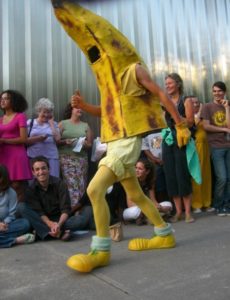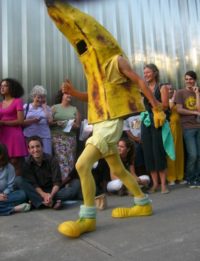The following essay, in the genre of memoir,
was published in November 2012 in an e-book
Parent-Child Memories
from the series Love Revealed, True Stories edited by Dena Clayton.
The story is true. Names have been changed to honor privacy concerns.
My son came home from school on Halloween day in the eleventh grade with his head down, dragging his feet. “Mrs. Nile called me to the counselor’s office today. She says I’m getting too thin. She said I’m looking a little yellow.”
In spite of my concern, I almost laughed. How could she even say that with a straight face? When he’d gone to school that morning, every inch of his exposed skin was tinted yellow. Dressed as a giant banana, yellow paper-mache covered his body down to his thighs and arched high over his head like a crescent moon. Beaming in the early morning light, he clopped across our living room in oversized yellow clown shoes, hard plastic slapping wood floors, mugging for photos. At his arts high school, Halloween was always celebrated with theatrical fanfare, including a special assembly where students paraded their costumes onstage to wild cheers and hearty applause. I enjoyed visiting his school on Halloween. Trailing in the wake of Banana Man, I lingered in the main hallway, spying a purple Barney dinosaur, Pippi Longstocking, and a dazzling Michael Jackson.
 Banana Man in a fashion show at the
Banana Man in a fashion show at the
Contemporary Arts Museum, Houston
The next morning, Mrs. Nile called. “Ms. Kern, I need to talk to you about William. Can you come up to school tomorrow?”
Her office was cramped, and not very private. “Have you noticed how thin William is? You need to take him to a doctor.” She went on talking about other troubled students under her charge, including the principal’s daughter. Since William’s dad and stepmother both taught at his school, I knew that anything I said to Mrs. Nile would not be held in confidence. I thanked her for her concern, and went home to start making phone calls and doing research.
It was true he was getting too thin. His stepmother had confronted him directly, but I hadn’t, because I was afraid I’d alienate him. I’d been aware he was troubled, but I hadn’t been able to persuade him to eat. He was such a sensitive boy. In second grade, when the kids drew pictures of what they wanted if they could have anything, the other boys drew red Lamborghinis and jet planes. William drew the Earth, and wrote in careful block letters, “World Peace” across the top. His teacher showed me his art, saying, “I want to clone this kid, so both my daughters can marry him.” As a child, he’d been solid, muscular, and wild about sports. In middle school, when he pitched his arm out playing baseball, he turned to basketball, spending hours playing pick-up games with a group of friends in our driveway.
Ten years after his drawing of the Earth, his arms and legs were thin as twigs. Dressed as Banana Man, he had reminded me of Mr. Peanut, his arms and legs like sticks with big joints.
William and I often had long conversations about the human condition. He was acutely aware of people’s suffering. After school, when he came into the kitchen for the usual snack, he would say, “I’m hungry but I just can’t let myself eat, when so many are starving.” In world history, he studied current events, and learned about genocide and starvation. The suffering of people in Africa and Asia wasn’t remote to him; he felt it in his body. When he read Siddhartha, the concept of renunciation seized his imagination. It wasn’t only food he denied himself, it was everything: clothes, books, or a new bicycle. He even balked at induction into the National Honor Society. “I’ve had all these advantages. My parents have always helped me and encouraged me. It’s not fair to the kids who haven’t had that.”
His doctor reassured me. “His blood work is normal.” Turning to William, Dr. Roberts said, “You’re thin, at the low end for your height, but you’re still inside the healthy range. But I want you to understand, you can’t afford to lose another pound.” He was losing muscle mass, and the doctor explained to us that if he kept not eating, his body would start consuming itself in an effort to survive. I felt a convulsion of fear. I’d heard of kids dying from anorexia.
“Even when I feel hungry, after I eat a few bites, I feel bloated,” he groaned. He wasn’t refusing to eat. He ate a lot, but only fruits, vegetables, beans and rice. He ate the whole apple, seeds and all. He ate the cob of the corn. He ate peels from the compost bucket. He preferred to eat scraps, leftovers, food no one else would eat. My chest tightened when I watched him, but I was afraid of losing him, so I held my tongue. I believed that if I gave him orders, he would tune me out. I reminded myself he was not in immediate danger. I wrested my mind away from worst-case scenarios: starvation, hospitalization, IV treatments.
When I was in high school, my family moved to Mississippi, where racial tension crackled in the hallways at school. Court-ordered desegregation brought the hatred and rage of a whole society boiling to the surface. I joined a tiny bi-racial committee of students who wanted to ease the way, but we were disbanded by the school administration. Facing such overwhelming pain and injustice on a large scale, I had trouble eating and sleeping.
Eventually, I found a therapist for William, who told me, “Don’t talk to William about your family history. Don’t talk to him about his father, or the divorce, unless he brings it up.” Seeing my son struggle triggered anxiety in me. I ruminated about my inadequacies as a mother. Where had his dad and I gone wrong? I needed guidance to help me know which of my impulses to help William were healthy. Even if I was part of the problem, I wanted to learn how to help him.
I wanted him to know he wasn’t alone. I didn’t want to alienate or abandon him. I didn’t know what to do, and he couldn’t tell me what he needed. I wanted to help him navigate the rocky path to adulthood, not try to control him. I had to let him show me how.
I instituted nightly sit-down dinners with William and his sister. No more being too busy for each other. We talked about our days, or sometimes we sat in awkward silence, but we stayed together. On weekends, we took long, meandering bike rides around the neighborhood, stopping to admire flowers and identify fruit trees. Growing within us was the desire to start our own garden.
We attended the Urban Harvest fruit tree sale in January. William glowed as we searched through rows of small trees in twenty-five gallon containers for a Red Baron peach, a Celeste fig. “Can we get a persimmon? What about blueberries?” I said yes to the light in his eyes.
Weekends and after school, we added compost and manure, making the soil dark and rich. When we dug deep with our shovels, we were careful to protect the delicate earthworms. Though small and ordinary, they would make our garden rich and fertile. We hauled heavy loads of recycled bricks and river rocks to build a medicine wheel. In the four quadrants, we planted lettuces from seeds so tiny; we simply lay them on the ground and sprinkled a few grains of soil over them. Lettuce was followed by tomatoes, chili peppers, sugar-snap peas, and Italian cucumbers a foot long. When we finished planting one area, we began planting another: lemon grass, basil, rosemary; roses, gardenias, and passion flowers.
As winter turned to spring, we pulled weeds. William showed me how to dig them out at their roots. Whenever I felt anxious, I remembered to feel my feet on the ground. Above us, the sky was bright blue, or grey and misty; the air was warm or chilly; a cardinal perched on the fence, or a hawk circled. When I noticed them, beauty and safety were present. As we worked side by side, day after day in our garden, I saw his old soul begin to come to terms with suffering.
Watching him eat sugar-snap peas straight from the vine, I saw him begin to feel more comfortable with food. He made tiny steps, allowing himself to receive. The day he let me buy him a new backpack for school, I cried. One afternoon in the fall of his senior year, as we stood watching the newly arrived monarch butterflies drinking nectar from the milkweed flowers, he turned to me, saying, “Thank you, Mom. I don’t know how I would’ve made it without your support.”
Learning to ask for help and receiving it, my son developed a strong inner foundation. His motto became balance. A year later, I helped him pack his things and drove him to college. He wrote his senior thesis on infant mortality in Bolivia. After graduating from college, he spent two months in Bolivia doing field research, and then traveled to Cambodia, where he works now in poverty alleviation. Even though he lives in Southeast Asia, he still dresses up for Halloween.
Author Statement:
I write memoir to parse the complexities of the human heart. Our need to survive drives us to fight threats against us and struggle against obstacles. Seemingly in contrast with the drive to fight to survive is a deep need for peace that comes through mercy, compassion and surrender. I teach a meditative process to support my students’ emotional, spiritual and creative needs at the Spectrum Center of Houston, and the Jung Center. I am grateful to the Spectrum Center Writers’ Guild and especially to Max Regan for his mentoring. 2-17-12
![Parent-Child Memories: Love Revealed (Love Revealed Stories Book 2) by [Kern, Nancy, Caffrey-Dobosh, Corby, Melotti-Cormack, Alison, Gordon, Susan, Ernst, Sindee, Krishnakamini, K., Williams, Marilyn Finch, Lackman-Smith, Carol, Briddell, Victoria Moo]](https://images-na.ssl-images-amazon.com/images/I/514H00XbebL.jpg) The full e-book Parent-Child Memories can be purchased on Amazon here.
The full e-book Parent-Child Memories can be purchased on Amazon here.



Such beautiful writing! You captured this moment I recognize so well as a mother, when we must ever so gently coax our child through the pain they see or experience in the world without losing themselves. Thank you for sharing this. Lovely!!
“I said yes to the light in his eyes.”
A beautiful tribute to love and a practical example of how to stay present to pain and allow healing to lead us home. Thank you for this wisdom. I always need to know this, to return to it, to be reminded that it matters and shown how to practice this kind of presence in life, with myself and others.
Rosa, I love how you expressed this passage.
Jennifer, I agree, when we stay present to pain we can allow healing to lead us home. Thank you for this.